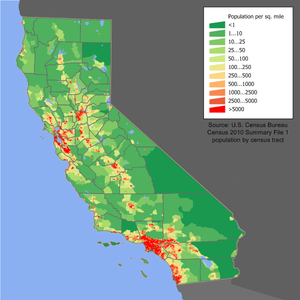Deliver Magazine
February 28, 2011 | by Paula Andruss

Where’d John Doe go?
…Be prepared to see some major demographic shifts, says demographic trends analyst Peter Francese, chief among them the absence of the “average American.”
Francese, who consults for advertising agency Ogilvy & Mather, recently authored 2010 America, a report commissioned by Advertising Age that highlights some significant population changes the census will reveal.
Here are five things he says marketers need to know about today’s consumer:
1. There’s no longer an “average American.”
 Image via Wikipedia…But I can predict with a high degree of certainty that the 2010 census will essentially put the last nail in the coffin of the “average American,” because he or she no longer exists.
Image via Wikipedia…But I can predict with a high degree of certainty that the 2010 census will essentially put the last nail in the coffin of the “average American,” because he or she no longer exists. Image via WikipediaIn our 10 largest cities and four states — California, Texas, New Mexico and Hawaii — no race or ethnicity is a majority of the population anymore. …
Image via WikipediaIn our 10 largest cities and four states — California, Texas, New Mexico and Hawaii — no race or ethnicity is a majority of the population anymore. …Also, the number of people who live alone is growing very rapidly; they’re now more than 27 percent of households.
The third dimension of complexity is that we are becoming a multigenerational society. … Multigenerational households and a multigenerational America means that older people (in their late 50s, 60s and 70s) have a bigger impact on what their children and grandchildren are doing and buying.
3. The multicultural shift is driven by immigration.
… So a higher proportion of the younger population — the children and young adults — are African-American, Hispanic, Asian or multiracial. As the older population ages and more of them pass on, the younger generation becomes a greater share of the total population. Young adults and children are quite diverse, whereas older people are not. Eighty percent of Americans over the age of 65 are white non-Hispanic, but that’s true of less than 60 percent of children.
4. Don’t treat each generation or age segment as independent entities.
It’s essential to address the multidimensional nature of our society today, and more important than ever to know more precisely who your customers are. In-depth interviews and surveys are vital tools for more effective direct marketing. We can’t assume that just because somebody is 60 or 70 years old that all they’re going to want is a hearing aid or health insurance, and there’s no point in marketing anything else to him. …
5. Direct mail will continue to play a crucial role.
Direct mail reaches people in their home and it offers something in writing, in their own language, that is of specific interest. It’s the ideal way to really target a specific part of a population that has a need that is unique for that group. …
In all of these groups, thinking of direct mail as a primary means of communication within your specific and detailed set of customers, and giving it the priority it deserves, can be very successful.







No comments:
Post a Comment